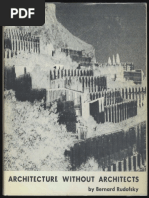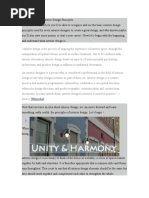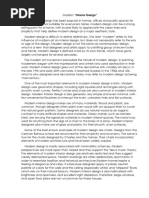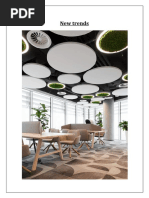0 ratings0% found this document useful (0 votes)
21 viewsDesign Nischal
Design Nischal
Uploaded by
nischalsilwal740Design serves as the blueprint that considers both the form and function of a space. Decoration adds finishing touches like art, textiles, and plants to enhance visual appeal and personality. Structure provides the framework and foundation, such as load-bearing walls and beams, to support the building safely and allow for flexibility in design. Together, design, decoration, and structure work collaboratively to create spaces that are both visually pleasing and functional.
Copyright:
© All Rights Reserved
Available Formats
Download as DOCX, PDF, TXT or read online from Scribd
Design Nischal
Design Nischal
Uploaded by
nischalsilwal7400 ratings0% found this document useful (0 votes)
21 views2 pagesDesign serves as the blueprint that considers both the form and function of a space. Decoration adds finishing touches like art, textiles, and plants to enhance visual appeal and personality. Structure provides the framework and foundation, such as load-bearing walls and beams, to support the building safely and allow for flexibility in design. Together, design, decoration, and structure work collaboratively to create spaces that are both visually pleasing and functional.
Original Title
Design_Nischal
Copyright
© © All Rights Reserved
Available Formats
DOCX, PDF, TXT or read online from Scribd
Share this document
Did you find this document useful?
Is this content inappropriate?
Design serves as the blueprint that considers both the form and function of a space. Decoration adds finishing touches like art, textiles, and plants to enhance visual appeal and personality. Structure provides the framework and foundation, such as load-bearing walls and beams, to support the building safely and allow for flexibility in design. Together, design, decoration, and structure work collaboratively to create spaces that are both visually pleasing and functional.
Copyright:
© All Rights Reserved
Available Formats
Download as DOCX, PDF, TXT or read online from Scribd
Download as docx, pdf, or txt
0 ratings0% found this document useful (0 votes)
21 views2 pagesDesign Nischal
Design Nischal
Uploaded by
nischalsilwal740Design serves as the blueprint that considers both the form and function of a space. Decoration adds finishing touches like art, textiles, and plants to enhance visual appeal and personality. Structure provides the framework and foundation, such as load-bearing walls and beams, to support the building safely and allow for flexibility in design. Together, design, decoration, and structure work collaboratively to create spaces that are both visually pleasing and functional.
Copyright:
© All Rights Reserved
Available Formats
Download as DOCX, PDF, TXT or read online from Scribd
Download as docx, pdf, or txt
You are on page 1of 2
Design-Decoration and Structure
Design, decoration, and structure are essential elements in the empire of
interior and architectural aesthetics. These components play a significant
role in shaping functionality, and overall appeal of a space. In this
exploration, we will dig into these facts, explaining their importance and
how they work together to create harmonious environments.
Design: Design serves as the blueprint for any interior or architectural
project. It encompasses the layout, flow, and overall concept of a space.
A well-thought-out design takes into account both form and function.
The form aspect focuses on aesthetics and style. Designers consider
elements such as color palettes, materials, furniture selection, and
lighting to create a visually appealing environment. For instance, a
minimalist design might feature clean lines, neutral colors, and simple
furniture, with vibrant colors, and a mix of textures.
On the other hand, the function aspect is equally vital. A good design
optimizes the use of space, ensuring it meets the practical needs of its
occupants. For example, in a kitchen, the layout should facilitate
efficient cooking, while in a living room, the arrangement of furniture
should encourage social interaction and relaxation.
Decoration: Decoration is the art of adding finishing touches to a space
to enhance its visual appeal and personality. It's the layer that adds
character and reflects the preferences of the occupants.
Decoration encompasses a wide array of elements, including wall art,
textiles, accessories, and even plants. These components inject color,
texture, and a sense of identity into a room. For instance, a space
adorned with vintage posters and antique furniture releases a nostalgic
charm, while a room adorned with vibrant modern art and glossy
furniture feels contemporary and energetic.
The key to successful decoration lies in balance. Overly cluttered spaces
can feel chaotic, while overly minimalistic ones may appear stark and
uninviting. A harmonious blend of different decorative elements, taking
into account the design's style, can create a visually pleasing
atmosphere.
Structure: Structure, in the context of architecture, refers to the
framework and foundation that supports a building. It is the backbone
upon which the design and decoration are built. The structural integrity
of a space is crucial for safety, durability, and functionality.
Architectural structure involves considerations like load-bearing walls,
beams, columns, and foundations. These elements ensure that a building
can withstand its own weight, environmental forces, and the intended
use of the space. A well-structured building provides a safe and stable
environment for its occupants.
Moreover, the structural layout can influence the design and decoration
choices. For instance, open-plan layouts with minimal structural
obstacles allow for more flexibility in interior design, while spaces with
numerous load-bearing walls may require creative solutions to optimize
aesthetics and functionality.
In conclusion, design, decoration, and structure are integral components
in creating harmonious spaces. They work in collaboration to produce
environments that are both visually appealing and functional. A
thoughtful design sets the stage, decoration adds character, and structural
integrity ensures safety and stability. By carefully considering these
three elements, architects and designers can craft spaces that inspire and
delight those who inhabit them, making every room a work of art in its
own right.
You might also like
- Theory of Interior DesignDocument20 pagesTheory of Interior DesignRidhima Sharma100% (8)
- Rudofsky Architecture Without Architect MomaDocument136 pagesRudofsky Architecture Without Architect MomaLeon100% (10)
- Interior Design - Module 1 (Notes)Document27 pagesInterior Design - Module 1 (Notes)Vinayak U (RA1911201010039)100% (1)
- Philosophy of RhythmDocument441 pagesPhilosophy of RhythmJesus Yusuf Isa Cuevas100% (4)
- Assignment On: Rimt College OF ArchitectureDocument17 pagesAssignment On: Rimt College OF ArchitectureMeghna BhandariNo ratings yet
- 7 Most Important Interior Design PrincipDocument15 pages7 Most Important Interior Design PrincipBruno ManciniNo ratings yet
- General Overview-Interior Design TrendDocument5 pagesGeneral Overview-Interior Design TrendSheril Chugh100% (1)
- The Naked MajaDocument2 pagesThe Naked Majasunq hccnNo ratings yet
- Magazine ContentDocument21 pagesMagazine ContentChristian James TuazonNo ratings yet
- How To Learn Interior Design: Interior Design For BeginnersFrom EverandHow To Learn Interior Design: Interior Design For BeginnersNo ratings yet
- Design Your Dream: A Guide to Furniture and Decor SelectionFrom EverandDesign Your Dream: A Guide to Furniture and Decor SelectionNo ratings yet
- MODULE AR 182 ArchitecturalinteriorsDocument57 pagesMODULE AR 182 ArchitecturalinteriorsSophie DatuNo ratings yet
- Mufazzal Sadhique 11 C 20720 D&T Final Project Word) )Document31 pagesMufazzal Sadhique 11 C 20720 D&T Final Project Word) )MUFAZZAL SADHIQUENo ratings yet
- Space Detailing Research.Document6 pagesSpace Detailing Research.giuNo ratings yet
- Interior Design - A Grounded Home in Dubai Inspired by The Modernist GreatsDocument9 pagesInterior Design - A Grounded Home in Dubai Inspired by The Modernist Greatsbl.fitoutNo ratings yet
- Screenshot 2024-03-13 at 04.13.29Document25 pagesScreenshot 2024-03-13 at 04.13.29sarahwilliams878766No ratings yet
- yesDocument18 pagesyes20510100284No ratings yet
- 1090132007_Saumyajit Basu_Construction Engineering And ManagementDocument11 pages1090132007_Saumyajit Basu_Construction Engineering And ManagementSaumyajit BasuNo ratings yet
- The in Uence of Interior Design On House: October 2019Document18 pagesThe in Uence of Interior Design On House: October 2019Dharani KellaNo ratings yet
- Guide To The Principals of Good Design in BuildingsDocument6 pagesGuide To The Principals of Good Design in BuildingsRoss CairnsNo ratings yet
- Application Study On Soft Decoration Materials in Modern Living SpaceDocument3 pagesApplication Study On Soft Decoration Materials in Modern Living SpaceafenuvonadebayorNo ratings yet
- Interior design-WPS OfficeDocument5 pagesInterior design-WPS OfficeFritz Vonn BulabonNo ratings yet
- 2 - Elements of Interior DesignDocument4 pages2 - Elements of Interior DesignYathaarth RastogiNo ratings yet
- Design ModernDocument2 pagesDesign ModernDamonNo ratings yet
- Chapter 2 Related LiteratureDocument19 pagesChapter 2 Related LiteraturemikokeeNo ratings yet
- Module 1.2 Interior SpaceDocument13 pagesModule 1.2 Interior SpaceagapejilyasorianoNo ratings yet
- FatmaDocument6 pagesFatmaMohamed AliNo ratings yet
- The Sustainable ApproachDocument15 pagesThe Sustainable ApproachJosh H. VelascoNo ratings yet
- BSC 6th Semester TheoryDocument45 pagesBSC 6th Semester Theorysumitha ganesanNo ratings yet
- Principales of Space PlanningDocument4 pagesPrincipales of Space PlanningAveNo ratings yet
- sT06wa4AgoDocument5 pagessT06wa4Agopradhansujoy941No ratings yet
- Interior Designing - ElementsDocument22 pagesInterior Designing - ElementsArhit's Game ZoneNo ratings yet
- Geometry in BusinessDocument2 pagesGeometry in BusinessHossain BabuNo ratings yet
- Id - 1 - IntroductionDocument121 pagesId - 1 - IntroductiongurulakshmiNo ratings yet
- What Makes a Bad Interior Design: Guide To Interior Design MistakesFrom EverandWhat Makes a Bad Interior Design: Guide To Interior Design MistakesNo ratings yet
- Research GiuDocument4 pagesResearch GiugiuNo ratings yet
- Architecture and AestheticsDocument3 pagesArchitecture and AestheticsKC GarceronNo ratings yet
- Introduction To Interior DesignDocument10 pagesIntroduction To Interior Designshorouq.rubaNo ratings yet
- Architect Skills and Qualities: Guide to Becoming a Good ArchitectFrom EverandArchitect Skills and Qualities: Guide to Becoming a Good ArchitectNo ratings yet
- Writesonic Chatsonic 1681016655270Document2 pagesWritesonic Chatsonic 1681016655270Jein Graceilyn L. CabangonNo ratings yet
- Unit 1 IntroductionDocument6 pagesUnit 1 Introductionlaxman15No ratings yet
- Design TheoryDocument2 pagesDesign Theoryhamidreza mohseniNo ratings yet
- Module 1 - Sample2Document7 pagesModule 1 - Sample2Mei-Ann Cayabyab-PatanoNo ratings yet
- dt fDocument20 pagesdt fsadmanhossain1282No ratings yet
- The Ultimate Guide To Nice Architecture DesignDocument6 pagesThe Ultimate Guide To Nice Architecture Designebrahim.mostafaNo ratings yet
- Notes 1: Architectural Design and Building PlansDocument9 pagesNotes 1: Architectural Design and Building PlansCorrinne TugononNo ratings yet
- Type TextDocument24 pagesType TextReeve Roger RoldanNo ratings yet
- DESIGN THEORYDocument22 pagesDESIGN THEORYsadmanhossain1282No ratings yet
- Ar 8004 Id Unit IiDocument84 pagesAr 8004 Id Unit Iiaurora krishreddyNo ratings yet
- Lesson 3Document3 pagesLesson 3JANELLE COSTALESNo ratings yet
- In What Ways Does The Concept of Volume and Surface Area in Geometry Relate To Our Understanding of Space and ArchitectureDocument5 pagesIn What Ways Does The Concept of Volume and Surface Area in Geometry Relate To Our Understanding of Space and Architecturekalaanime2008No ratings yet
- Upcoming TrendsDocument8 pagesUpcoming TrendsKirti gargNo ratings yet
- Structural Considerations: and Its Resulting SpaceDocument36 pagesStructural Considerations: and Its Resulting SpaceKiara AlejandrinoNo ratings yet
- Elements and Principles WRT Colors in InterioDocument22 pagesElements and Principles WRT Colors in InterioSRESTAA BHATTARAINo ratings yet
- Interior Design Viii: Assignment 2Document12 pagesInterior Design Viii: Assignment 2Vidhisha Bhargava100% (1)
- Living Room DesignDocument51 pagesLiving Room DesignpvamshiNo ratings yet
- History Theory of Architecture - Topic IVDocument7 pagesHistory Theory of Architecture - Topic IVbrianNo ratings yet
- Theory of Interior Design: Assignment Submitted by Aaditya, Danu, RitikaDocument61 pagesTheory of Interior Design: Assignment Submitted by Aaditya, Danu, RitikaNancy TessNo ratings yet
- Elements and PrinciplesDocument6 pagesElements and PrinciplesZachary Yassir GonzalezNo ratings yet
- 119ar0009, Bhaskara Rao - Interior Design, Assignment-2Document16 pages119ar0009, Bhaskara Rao - Interior Design, Assignment-2Raghava ArigelaNo ratings yet
- MAPEH+GRADE+9+DLL Updated Converted by AbcdpdfDocument65 pagesMAPEH+GRADE+9+DLL Updated Converted by AbcdpdfMORENO BACO100% (1)
- Discussion On The Evolution Causes of Japanese Ceramic Design StyleDocument3 pagesDiscussion On The Evolution Causes of Japanese Ceramic Design Stylecamellias, is that you?No ratings yet
- Employment News 30 December - 05 January PDFDocument40 pagesEmployment News 30 December - 05 January PDFajeetsinghkatiyarNo ratings yet
- Bản sao của READING PART 3 + 4Document7 pagesBản sao của READING PART 3 + 4Phạm SơnNo ratings yet
- 01 Ge116 PrelimDocument32 pages01 Ge116 PrelimRian Marc AbellanaNo ratings yet
- MEDIUMDocument37 pagesMEDIUMXXXNo ratings yet
- 2017 Fall Art 101-02Document7 pages2017 Fall Art 101-02uogufc1No ratings yet
- Cultural Richness-Activities and Characteristics That Define A CultureDocument11 pagesCultural Richness-Activities and Characteristics That Define A CultureSSNo ratings yet
- StudentHandbook2019 2020 - Rev 2 201907291607Document95 pagesStudentHandbook2019 2020 - Rev 2 201907291607Gab AquinoNo ratings yet
- The Eisenstein Universe (Ian Christie and Julia Vassilieva)Document313 pagesThe Eisenstein Universe (Ian Christie and Julia Vassilieva)Peshraw BenNo ratings yet
- Artist and The Artisan His MediumDocument36 pagesArtist and The Artisan His MediumCharmaine JanorasNo ratings yet
- Art Lesson Plan African Coil PotsDocument2 pagesArt Lesson Plan African Coil Potsapi-265299771No ratings yet
- Essay About The Parisian LifeDocument2 pagesEssay About The Parisian LifeFaith BangcoNo ratings yet
- Yoram Rabin, The Many Faces of The Right To Education, Exploring Social Rights - Between Theory and Practice 265Document24 pagesYoram Rabin, The Many Faces of The Right To Education, Exploring Social Rights - Between Theory and Practice 265יורם רביןNo ratings yet
- Three Ages of Woman by Gustav Klimt - My Daily Art DisplayDocument4 pagesThree Ages of Woman by Gustav Klimt - My Daily Art DisplaySarkis KanaanNo ratings yet
- One Art EssayDocument2 pagesOne Art Essayb71bpjha100% (2)
- Function of ArtsDocument20 pagesFunction of Artsapi-558067955No ratings yet
- Context and Architecture - A DissertationDocument53 pagesContext and Architecture - A DissertationAbishaTeslinNo ratings yet
- Nail Designing ToolsDocument19 pagesNail Designing Toolshrshy prz100% (1)
- European Comic Art) IntroductionDocument5 pagesEuropean Comic Art) IntroductionGeovanaNo ratings yet
- A Brief History, The Edo Period-EMiDocument2 pagesA Brief History, The Edo Period-EMiemilyNo ratings yet
- Essay On SculptureDocument3 pagesEssay On Sculptureafhbebhff100% (2)
- Arts in The PhilippinesDocument6 pagesArts in The PhilippinesErianne OrainNo ratings yet
- Q2 WK1 Worksheet1 ARTS9Document8 pagesQ2 WK1 Worksheet1 ARTS9PJNo ratings yet
- Grade 7 Module (Day 1)Document4 pagesGrade 7 Module (Day 1)Jan Melvin SaturosNo ratings yet
- Principles of Design - Art AppreciationDocument26 pagesPrinciples of Design - Art AppreciationDANE PIAMONTENo ratings yet
- The Legend of The Seven WhalesDocument1 pageThe Legend of The Seven WhalesSue WestNo ratings yet

























































































